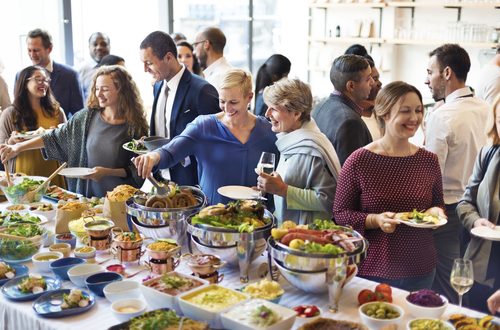We live in a world where we are compared and judged. Business and social dining each play a role in your everyday life, whether at a networking event, a lunch meeting, or at a meal with a prospective employer. Your polished dining skills will help to create a very positive impression of both you and the brand which you represent.
Below are the questions that I have been asked most frequently by professionals in all areas of both business and social dining. There have been so many questions, that I’ve created a four part series to respond. You may see yourself in some of the questions and answers listed below. Read these, practice, relax and enjoy your dining experience:
- When may I begin to talk business at a business meal? The conversation is social until the main course arrives unless both parties have agreed beforehand that this is a working lunch. If the business matter is of some urgency, then after the meal orders have been placed, it is appropriate to move the conversation toward your business agenda.
- When may I use electronics at a business meal? All electronics are turned off at this meal. If you are the host and you are awaiting an important call, let your client or guest know that you may be excusing yourself during the meal for a matter than cannot wait. Place your telephone on vibrate. Do not place it, or other electronics, on the table. Do not answer your cell phone at the table. As the guest, your cell phone is turned off and is not visible. Your tablet/laptop is only placed on the table if a working meal was discussed prior to the actual meal. Tablets and laptops are best used after the meal is cleared. Please refrain from checking your smart watch. This may look like you are not paying close attention to your host or prospective client.
- I’ve dropped my fork or spoon. What shall I do? You may accidentally drop your knife, fork or spoon from the table. Do not attempt to retrieve the cutlery. Politely ask your server for a replacement. If the item puts a server or other guest in harm’s way, simply nudge the item back toward the table with your foot. This advice also applies to dropped napkins. Do not pick a dropped napkin up from the floor. Quietly ask your server for another.
- How do I remove food from my mouth? The general rule is that food comes out of your mouth the way that it went in. So, if you ate the item with a fork, it would be removed that way. If it is finger food, you would remove it with your fingers. Having said that, do what is simplest. Either remove the food with your fingers or by quickly depositing it on to your fork. Then place this bit of food on to your plate. Hide this small piece of food, pit, seed or bone under a piece of parsley or other food. Do not discuss the removal with anyone at the table. Just do it quickly. Do not draw attention to yourself. Absolutely never tent your hands or hold your napkin over your mouth to disguise this operation.
- How do I handle a spill at the table? How embarrassing! You’ve spilled your water or wine on yourself, a dining companion, or on the tablecloth. Remain calm. If you’ve spilled on yourself, politely say, “Excuse me” to the person on either side of you and take care of the spill in the restroom. After you have left the table you may ask one of the servers for some club soda for the stain. If you’ve spilled on someone else, DO NOT TOUCH THIS PERSON. Apologize and offer your napkin. Get a server to bring some club soda for your dining companion. Quietly insist on paying the dry cleaning bill. Do so calmly. You should not make a small embarrassment into a larger one. The same goes for spilling on the table itself. The server will take care of this.
- What if the spill occurs in a private home? The host or hostess is sure to jump up and take care of it. You must privately speak with your host and insist on having the tablecloth dry cleaned or replaced. Since most hosts would never accept your gesture, you must both call and write a note of apology to your host or hostess. Depending on the damage and the relationship, consider sending flowers with your note of apology to the hostess.
- How fast should I eat? Pace yourself throughout the meal. You do not want to be the first guest finished. You also don’t want to be the last. Everyone else will have to wait to enjoy the next course if you dawdle. Be observant. Eat slowly if most of your dining companions are lagging behind you. Eat more quickly if you have been absorbed in conversation and notice that your table companions are close to finished with their meals.
- Where do my hands go? In the American style of dining, when your hands are not in use you may place them on your lap. It is also correct to leave one hand on the table (at the wrist) between courses. In the Continental style, you absolutely must leave both hands, placed at the wrist, on the table. This custom came from medieval Europe. The host wanted to see both hands of his guests to make sure there were no hidden weapons.
- What do I do with the napkin ring? The napkin, inside the napkin ring, is set on the table with its point facing the diner. Hold the napkin in your right hand. Pull the ring away from the napkin with your left hand. Place napkin ring at the top and to the left of your plate and dining utensils. Place the napkin in your lap. Unfold the napkin under that table. The fold of the napkin is placed at your waist.
- Doesn’t the server remove the napkin ring from the table? Usually. If not, at the end of the meal, loosely refold your napkin, pull it back through the ring and place your soiled napkin to the left side of your dinner plate so that the point of the napkin faces the center of the table.
- What’s the purpose of napkin rings? Originally, napkin rings were personalized so that each member of the family could easily identify and reuse his or her cloth napkin. This was before we all had washers and dryers. After World War II, napkin rings lost favor as paper napkins became popular for family meals. Today, napkin rings are used as a festive and decorative touch and are not used in formal dining.
If you do forget some small point of etiquette, just slow down and watch what your host and others around you are doing. Dining is supposed to be fun, so relax and delight in the occasion.
Parts 2, 3, and 4 of “Most Frequently Asked Dining Questions” will appear in my next posts.
Excerpts of blog or article may have been taken from the book: Hospitality Management – People Skills & Manners on and off the Job. Copyright © 2015 Lyn Pont, Ph.D.
“Pont’s book is a must-read for anyone considering a career in hospitality.”
— Isadore Sharp, chairman and founder, Four Seasons Hotels and Resorts
See the book at: www.HospitalityManners.com
Visit Lyn at: www.MannersForBusiness.com
Lyn Pont, Ph.D. – World’s Top 30 Hospitality Professionals, Global Gurus
#hospitality #dining #etiquette #tourism #hotels #guests #business #culture




